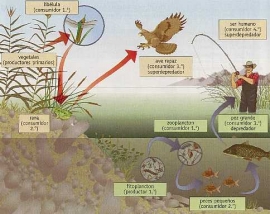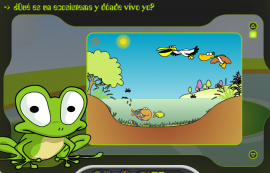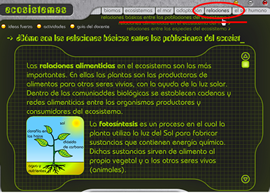Activity 2
Aquatic ecosystems
Now you know the components and characteristics of a terrestrial ecosystem. Are aquatic ecosystems similar? Let’s see…
AQUATIC ECOSYSTEMS
We all know that life on Earth would be impossible without water. It is essential to life. Aquatic ecosystems
are of vital importance and generally, contain a great variety of plant and animal species.
There are two types of aquatic ecosystems: marine ecosystems and freshwater ecosystems .
A marine ecosystem includes oceans, seas, marshes, etc., fantastic places
to develop lifep>
As in all ecosystems, in the sea, there are biotic and abiotic factors, like, salt and dissolved oxygen.
The sea bed is also important as some creatures, like snails move around on it or others are fixed in it, like coral. Other
factors include, temperature, light, marine currents, etc.
Look at this presentation of marine photos. Look at the animals but remember, there are many different
factors which make up this ecosystem.
Source: http://youtu.be/7Rb1mmpAVys
The freshwater ecosystems include rivers, lakes and lagoons, artificial lakes and reservoirs,
etc. As well as a many different fish, there are also amphibians and very important and abundant plant life. Some species
come and go looking for food or to breed.
Access http://portal.perueduca.edu.pe/modulos/r_ecosistemas/ecosistemas.html
To see a fresh water ecosystem animation.
Click on the green button and on the tab, “ecosystem” to meet Sapito.
Activity
Observe the environment where Sapito lives and identify living things and inert components. In groups, complete the following
file
aquatic_ecosystem.zip (.odt)
To analyse the relationships in Sapito’s ecosystem go to “Relaciones” in this web site
http://portal.perueduca.edu.pe/modulos/r_ecosistemas/ecosistemas.html
click on“
relaciones” then, the first option “
relaciones básicas entre las poblaciones del ecosistema ”
as in this image:
Now, go back to your file and try to complete the relationships table. You need to choose two elements from the biotic and
abiotic factors and write a sentence to describe their relationship. For example in your table you have:
Abiotic factors
| Biotic factors
|
Water
| Seaweed
|
Sun
| insect larva
|
Choose 2 or 3 elements and in the table “Relationships” write:
Relationships
|
- Seaweed needs sunlight to live.
|
- insect larva eat seaweed.
|
- Seaweed and insect larva live in water.
|
Share your ideas on the digital board with the class. Did other groups write about different relationships? Are they correct?
Apart from food, did you identify other relationships?
















